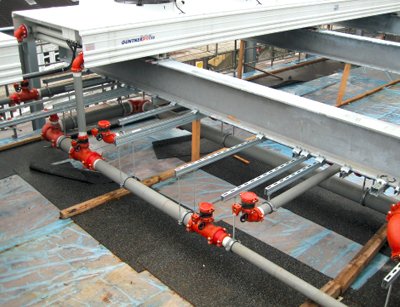When consulting engineers Hilson Moran designed the cooling system for a financial institution’s data center in Essex, UK, it originally drew a conventional welded and threaded HVAC system. Key issues for the client were completing the installation on time at a reasonable cost, without sacrificing quality of product due to the critical applications involved in the project.
The system required long (60m) runs of large-diameter piping – up to 350mm. Because this would be time-consuming and costly to weld, the engineers sought an alternative to meet the client’s needs for a speedy, clean and cost-efficient installation.
HVAC systems play a major part in the whole-life performance of data centers. A traditional HVAC system can account for up to 54% of a facility’s energy consumption but a thoughtfully designed system using efficient installation methods and high-quality components and controls can reduce this to 22%.
For many years, air-cooled systems provided sufficient cooling capacity, however, increased computing density produces more heat and requires more efficient cooling. In larger data centers, the most cost-effective method is a chilled water system. According to the Science of Aquatics, water is 4,000 times more efficient than air. This is why, in recent years, companies like IBM have developed methods for bringing cooling water directly into server racks.
In a chilled water system, cool water is pumped out of the mechanical room and into computer room air handlers by way of under-floor water distribution lines. The air handler then removes heat and humidity by drawing warm air through coils filled with circulating chilled water. The water absorbs the heat from the air and circulates back to the chiller where the heat is transferred to a condenser water loop and eventually released through a cooling tower.
Hard piping utilizing carbon steel pipe or copper tubing is common in a chilled water system. Traditional pipe joining methods for hard piping systems consist of welding, brazing or flanging which generally work well in data centers. But, with increased loads, frequent changes, and system expansions, these joining methods have become problematic. They are not easily accessible, feature limited design flexibility, introduce fire hazards to the jobsite and require lengthy system shutdowns to perform routine or unplanned maintenance activities.
This is where grooved mechanical piping technology comes into play – a method of pipe joining that requires no flame, with reduced deployment time, providing an easily adaptable system and reducing downtime during routine or unscheduled maintenance.
Hilson Moran installed a flame-free system of grooved-end pipe joining for the 350mm chilled water and ice water piping systems for its Essex client. “Trying to weld that size of pipework would have meant quite a considerable increase in labour time and costs so we recommended an alternative,” Hilson Moran contracts manager, Peter Dulieu says. “Using grooved mechanical piping speeds up the process and has the added advantage of cleanliness over welding.”
How grooved piping works
To form strong and reliable joints on large carbon steel pipes, a Victaulic Advanced Grooved System (AGS) was used. This is wider and deeper than standard grooved systems. The wider gasket gives more contact area for sealing. The two-piece housing of the coupling speeds up handling and installation time, and a union at every joint makes for easy adjustment, system maintenance or expansion.
Over the operating life of a data center, a piping system requires three basic categories of maintenance: routine inspection and maintenance, physical changes or expansion, and unscheduled repairs.
Grooved couplings provide a union at every joint, which allows for easy system access, maximum field flexibility for on-site decision making and flexibility for future system expansion. To access the system, a worker needs to de-pressurize it and simply unscrews two nuts.
To complete the job, the gasket is re-installed, coupling placed back and bolts are tightened.
Welded systems don’t have unions; to repair the piping system workers actually have to cut out the damaged pipe section. Because grooved mechanical pipe joints can be installed on wet lines there is no time required to let the system dry out.
In a traditional flanged system, multiple bolts are needed to create the seal, and removing these is a time-consuming process. When the multiple bolts are removed and the flanges pulled apart, the gasket will tear and need to be replaced.
With mechanical coupling, the compression loads on the gasket are different than the flange – it has a C-shaped cross section seal that is pressure responsive and designed to handle cyclical loading. Systems can be pressurized and depressurized repeatedly for many years without fatiguing the elastomer material. This also means expansion projects can be completed in occupied buildings without vacating the space because mechanical grooved piping does not release noxious fumes or introduce a fire hazard.
The grooved mechanical pipe joining system also accommodates movement and deflections within the piping system, reducing the need for periodic product repair or replacement.
The surge in popularity of grooved mechanical piping is due partly to the ever-increasing demand to save installation time on site and to engineers’ desire to build reliable, maintenance-friendly systems from day one.
This article first appeared in DatacenterDynamics' FOCUS magazine, Issue 23. To sign up for your digital edition, click here.

